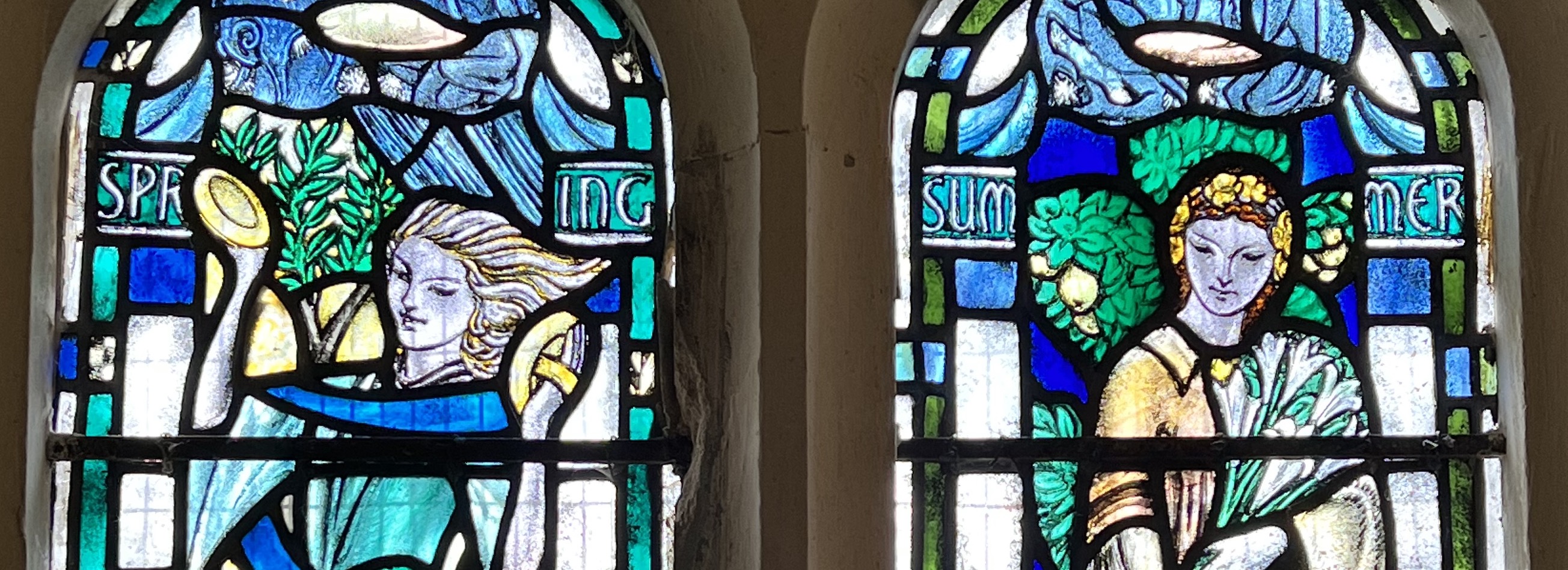Visiting our windows
We have occasional talks on the building, including a look around the stained glass windows. You are very welcome to join us for a service (details of timing on our calendar) and to take a look around the windows afterwards. Alternatively, if you would like a visit and/or to take some photographs, please contact churchwarden Brian Clegg by email.
Victorian glass
The 1830's saw the Stained Glass Industry in England at its height, with a number of companies, primarily based in London, designing and manufacturing the most beautiful stained glass works of art, the like of which will never be seen again. The largest of the stained glass companies employed in excess of 300 craftsmen working 24 hours per day in shifts, such was the demand.
Luckily, St Andrew's has a selection of windows from some of the most famous companies including Robert Douglas Strachan, Lavers, Barraud & Westlake, Herbert William Bryans and Heaton, Butler & Bayne who became world renowned, providing windows to Westminster Abbey (the Brunel Memorial Window) in the same year that St Andrews underwent a major refurbishment (1868), St Martins Cathedral, Leicester, Peterborough Cathedral (1864), Wimbourne Minister (The Great West Window – 1857), Tewkesbury Abbey (1869), St Matthews Cathedral, Wyoming, USA, the Cathedral of the Holy Trinity in Quebec, Canada, The Church of Jesus Christ in St Petersburg, Russia and many hundreds more throughout Britain, the Empire and the United States.
Clement Heaton (1824-1882) was born in Bradford-on-Avon, the son of a Methodist Minister. He started producing stained glass in 1850. He is also said to have influenced Pugin. Heaton worked as a glass painter for William Holland of Warwick. It is there that he met and went into partnership in 1855, with James Butler (1830-1913) who was the lead glazier at William Holland's Studio.
In the early years (1859-1861) Heaton and Butler had an arrangement and worked with Clayton & Bell in London (another of the great stained glass companies), until they had their own design team headed by Robert Turnill Bayne (1837-1915), who came from Clayton & Bell. Bayne joined Heaton and Butler in 1860 and became a partner in 1862. The company became known for the use of a very large range and colour of glass, for bearded figures and for exquisite painted detail. Heaton, Butler & Bayne were based in Covent Garden in London.
In 1864 the company began to use the services of the artist Henry Holiday as a freelance designer and this arrangement lasted until 1878. The Brunel Memorial Window in Westminster Abbey was one such work by Henry Holiday.

The Heaton, Butler & Bayne window in St Andrews in Blunsdon, depicts Jesus raising Lazarus four days after his entombment – John Chapter 11 - and has a supposed error in it – Come and see if you can find the error!
Twentieth century glass

One of the most interesting architectural features of St Andrew's is the set of stained glass windows depicting Christ the Good Shepherd and the four seasons, by prominent 20th century Scottish stained glass window designer Douglas Strachan. The windows were installed in 1947 on behalf of Sarah and Alexander Lonsdale Fell, in memory of their son, Robert.
'Medieval' glass

During the civil war, many churches had their stained glass windows smashed. One window at St Andrew's features fragments of pre-civil war glass that were discovered and reassembled in the Victorian reconstruction of the building. It is thought that the window is likely to have been constructed by the London Studios of Lavers, Barraud & Westlake. New painted and stained glass pieces were added to match the found fragments. We don't know for sure how old the original parts of the window are: stained glass was first used in the 7th century but became common place around 1200 AD. It was probably installed in the first building at St Andrews around 1200 - 1250.
